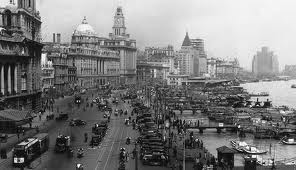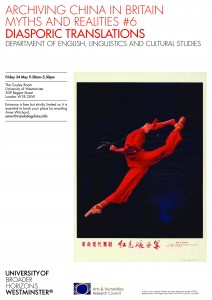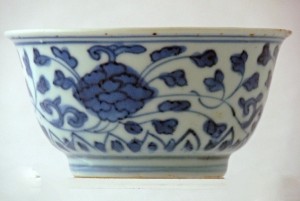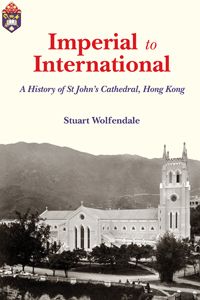Posted: May 14th, 2013 | No Comments »
Saturday 18th May 2013
10am start
The meeting point will be advised with booking confirmation.
Finish time approximately 12 noon
Â
SVEN AARNE SERRANO
with BETTY BARR
Â
A Walk to D, E, F Blocks and the Dew Drop Inn
The Lunghwa C.A.C. site today

WALK:Â Â Sven will guide RAS members and guests on a short one hour tour of the Shanghai Middle School/SHSID campus, located at 989 Baise Road, next to the Shanghai Botanical Gardens. Sven will take the tour to see the six surviving buildings from the Lunghwa C.A.C. site including the former D, E, F Blocks, the Assembly Centre, the former Guards barracks, and the Commissary.
Sven Aarne Serrano, Faculty, History Dept at Shanghai High School International Division, b. 1958, San Diego, California.The perfect Shanghailander, dual national Sven is married to a local Xuhui girl, and works at SHSID, the former site of the WWII Lunghwa Civil Assembly Center. He moved to Shanghai in 2008 after working for 17 years in Osaka, Japan where he taught English at Kindai University.
Sven is now developing a phone app project that will meld old photographs of Shanghai Middle School and their current views so future visitors to the campus can easily access the past.

RSVP: to RAS Bookings at: bookings@royalasiaticsociety.org.cn
WEBSITE: www.royalasiaticsociety.org.cn
 Â
N.B. This RAS Weekender will be a limited number participation event – maximum 20Â participants on a first come first served basis.
Priority for RAS Members.
ENTRANCE: 100 rmb (RAS members) and 200 rmb (non-members).
Â
MEMBERSHIP applications and membership renewals will be available at this event.
Posted: May 13th, 2013 | No Comments »
From the Shanghaiist.com website:

We are proud to announce a new monthly feature: The Shanghaiist Book Club.
Here’s how the book club will work: Shanghaiist staff and readers select a China-related book each month (we’ve chosen the first one ourselves). You read the book. We create a special book club post to talk about the books and you join the discussion in the comments.
For our first instalment, we’ll be reading Badlands: Decadent Playground of Old Peking by Paul French.
Paul French is the author of the excellent Midnight in Peking: The Murder That Haunted the Last Days of Old China (previously), which is currently being adapted for television. Paul has lived in Shanghai for a number of years and has written extensively about the history of the city and its people.
Badlands is Paul French’s follow up to Midnight in Peking:
The Badlands, a warren of narrow hutongs in the eastern district of pre-communist Peking, had its heyday in the 1930s. Home to the city’s drifters, misfits and the odd bohemian, it was a place of opium dens, divebars, brothels, flophouses and cabarets, and was infamous for its ability to satisfy every human desire from the exotically entertaining to the criminally depraved.These vignettes of eight non-Chinese residents of the precinct – White Russians, Americans and Europeans – bring the Badlands vividly back to life, providing a short but potent account of a place and a way of life until now largely forgotten, but here rendered unforgettable.
Here’s how to get your hands on a copy of Badlands:
– As a Kindle Single through Amazon UK
As a kindle from Amazon US
– As an eBook from Penguin Australia (available internationally)
– As a Barnes and Noble Nook Single
– As a limited edition hardback from select stores in Shanghai (Garden Books, Book Cup shops, Foreign Languages Book Stores) and Hong Kong and Amazon.cn
– In Chinese from Chinese language book stores in mainland China
We’ll reconvene in one month to discuss Badlands (and choose next month’s book). Paul French has kindly agreed to answer any questions you might have about this book and his other works, please email info@shanghaiist.com with ‘Book Club’ in the subject line.

Posted: May 12th, 2013 | No Comments »
Please join us for a glass of wine and tales of old Shanghai –
Â
Thursday 16 May 2013
7 pm for 7.30pm start
RAS Library at the Sino-British College
1195 Fuxing Zhong Lu

 AN EVENING with LIZ BARRON
Sharing notes from her Grandfather’s diary, her Grandmother’s letters and a film from their time in Shanghai.
“My Grandfather W.A.L Pardoe, left Barry in Wales, when he was about 21, to travel to Shanghai where he had a job as second surveyor with the Shanghai Municipal Council. He went by train and I have a copy of the diary he kept on his trip through Europe, Russia and Siberia.
Â
Grandpa met and married Granny in Shanghai and my Dad and his brothers and sister were born there. The boys came back to England to school when they were about 11 and Granny came back in 1936 with my Aunt Jane leaving Grandpa to follow in 1940.
Â
Since I was a very little girl I had wanted to go to Shanghai and used to love to look at the Chinese things which Granny had in their house in Somerset.
Â
I have always been greedy for information about Dad and Grandpa’s time in Shanghai and used to say that when I finally received a promised inheritance from my Granny’s estate, I would go to Barry Station in Wales and ask for two single tickets to Shanghai!
Â
Deciding to spend some of our children’s inheritance brought the chance of a “big trip” nearer and once I noticed the date Grandpa left Wales there was no doubt about when and where we would go!
Â
Grandpa left Barry on the 15.40 train on April 20th 1913 and we will leave Barry on the 15.40 train exactly 100 years later. We will travel the same route by train and ferry and hope to replicate some of the photos I have of Grandpas trip and of the first months he was in Shanghai.
RSVP: to RAS Bookings at: bookings@royalasiaticsociety.org.cn
 Â
ENTRANCE: 30 rmb (RAS members) and 80 rmb (guests). Includes a glass of wine or soft drink. Priority for RAS members. Those unable to make the donation but wishing to attend may contact us for exemption.
Â
MEMBERSHIP applications and membership renewals will be available at this event.
Â
RAS MONOGRAPHS – Series 1 & 2 will be available for sale at this event. 100 rmb each (cash sale only)
Â
WEBSITE: www.royalasiaticsociety.org.cn
Posted: May 10th, 2013 | No Comments »
Advance notice of the next, and last, in the Britain in China conference series at University of Westminster in London – NB: registration and attendance is free

China in Britain # 6: Diasporic Translations                     Â
Friday 24th May, 2013
9.30am – Coffee served in Room UG05
10.00am – ‘The work of Ming-Ai (London) Institute 院 徽 涵 æ„ and their historical project on British Chinese history’
Chungwen Li and Aubrey Ko will be talking about Ming-Ai, set up in 1993 to promote social, cultural, educational and economic exchanges among the peoples of Hong Kong, China and Britain, http://www.ming-ai.org.uk
Chungwen Li is originally from Taiwan but was brought up in Hong Kong. She has developed British-Chinese heritage projects for Ming-Ai since 2009 and is interested in cultural comparative studies. Developed projects so far are East West Festive Cultures, The Evolution and History of British Chinese Workforce, British Chinese Food Culture, and now a 3-year project, begun in July 2012, British Chinese Workforce Heritage. Aubrey Ko is the Research and Development Co-ordinator for Ming-Ai. She has extensive experience in managing community, schools, and cultural projects in the UK. She was born in Hong Kong and started her career in educational publishing after she graduated from Hong Kong University. She finished her Masters degree in Education at the University of Birmingham and then started working in the community sector in London.
10.30am – ‘On Not Speaking Chinese – The Hidden Lives of the Chinese in the Caribbean’
Chrys Chijiutomi, Associate Research Assistant for ‘China in Britain: Myths and Realities’ # 6, currently taking the MA, Culture Diaspora Ethnicity at Birkbeck College, University of London.Â
This paper will examine the historical and contemporary presence of Chinese communities in the Caribbean and consider what ‘Chineseness’ means in an age of globalisation and diaspora, looking at the socio-cultural impact and influences of Chinese Caribbean communities on artforms such as music (e.g. reggae), literature, theatre, dance, food cultures and visual art.
Chrys works as a freelance Creative Producer/Artist Manager for camoci running independent record label ‘camoci records’ and ‘camocivision’. She was Creative Producer of Arkestra Makara – a Pan-Asian chamber orchestra, created especially for the London 2012 Cultural Olympiad with clarinetist/composer Arun Ghosh, culminating in a performance on the BT River of Music Asia Stage at Battersea Park. Arkestra Makara brought musicians together from across the continent, including Bhutan, India, Japan, the Maldives, Nepal, Burma, the Philippines, Singapore, Malaysia, South Korea and Sri Lanka, as well as the UK.
11.00am – Morning Coffee served in Room UG05
11.15am – ‘China in Britain: China in the Caribbean’Â
Dr. Judith Misrahi-Barak (Paul-Valéry University Montpellier III, France).
Judith Misrahi-Barak is Co-director of the Cerpac (Research Centre on the Commonwealth) where she has organised several international conferences. She has published a variety of articles on Caribbean writers and the Caribbean diaspora.
11.45am – Diasporic Migrations panel chaired by Dr. Diana Yeh
12.00pm – ‘How Jim was Shanghaied: 1930s Shanghai and its lasting influence on the writing of JG Ballard’
Duncan Hewitt (New York University in Shanghai)
The unique environment of the Shanghai of the 1930s and ‘40s has exerted a lasting influence on the world of English literature through its impact on the distinctive vision of the writer JG Ballard. This paper looks at how Shanghai’s rampant consumerism, highly developed media culture and constant threat of violence influenced not only those of Ballard’s works which deal explicitly with his Shanghai childhood, but also the author’s writing and worldview throughout his career. It’s something Ballard initially denied, but came to acknowledge in his later years – though it’s a connection which has yet to be embraced by the Shanghai authorities.
Duncan Hewitt is a former BBC China correspondent who now writes for Newsweek and other media from Shanghai, and teaches Journalism and Chinese Media at New York University’s Shanghai centre, where he is also an advisor to the Shanghai Studies Symposium. He first lived in China from 1986-7, while studying for his degree in Chinese from Edinburgh University. A brief spell as an extra in the filming of Empire of the Sun at that time gave him a lasting interest in both Shanghai history and the work of JG Ballard. He has an MA in Southeast Asian Studies from SOAS, and is the author of Getting Rich First – Life in a changing China (Vintage, 2008). In 2011 he was a journalist fellow at the Reuters Institute for the Study of Journalism, Oxford University, where he researched the relationship between China and the Western media.
12:45 – ‘East West Connectivities in Two Dances: Red Detachment of Women (1964) and The Nightingale (1981)’
Dr. Geraldine Morris (Roehampton University)Â
The paper examines the notion of identity by reference to two dance works created in contrasting nations, the Peoples Republic of China and the United Kingdom, and considers the extent to which an aesthetic object can be a representation of a country’s culture. Using a multidisciplinary approach, Morris will examine the ways in which opposing ideologies merge in these works producing an East/West fusion. Red Detachment of Women (1964), created by a collaborative team of three, Li Chengxiang, Jiang Zuhui and Wang Xixian, was made in the years leading up to the Cultural Revolution. It was conceived as a patriotic, anti-bourgeois work, derived entirely from Chinese values, and yet is suffused with Western ideals and imagery. The Nightingale (1981) choreographed by Frederick Ashton, the founder choreographer of the Royal Ballet, is a hybrid work, comprising dance and song mixing East and West but perceived as Western. Dances are identified mainly through their choreography, so a dance that embodies a Western style of movement can only ever be partially Eastern, whatever the narrative content. In Red Detachment of Women, while the story, sets and costume are evidently Chinese, the movement and form is balletic and embraces a Western aesthetic. In contrast, The Nightingale borrows from Chinese regional dance but is framed by British balletic culture. The paper demonstrates that by teasing out the complexities of a dance work, the perception of its cultural identity can be both disturbed and challenged.
Geraldine Morris danced with The Royal Ballet Company and subsequently completed a PhD. She now works as a Senior Lecturer at Roehampton University and has recently published a book on choreographic style, Frederick Ashton’s Ballets: Style Performance Choreography.Â
1.15pm – Diasporic Cultural Translations panel chaired by Dr. Anne Witchard
1.30 – Buffet Lunch in Room UG05
2:15pm – ‘Only Connect: New Media and Chinese Overseas from the Age of the Telegraph to that of the Internet’
Jeffrey Wasserstrom (Chancellor’s Professor of History at University of California, Irvine)
This presentation will look at comparisons and contrasts between the ways that different technologies of communication have fascinated and been used by Chinese to keep in touch with one another and learn about the world from the 1870s through the present. Points of departure will include globetrotter Li Gui’s accounts of telegraphy in his book about his 1876 trips around the world; the role that circular telegraphs played in political struggles of the late 1800s and early 1900s; the significance of the then-very-new form of email in spreading word of the Tian’anmen rising among Chinese studying in the West; and the growing importance of blogs, microblogs, online only journals, and other digital forms in connecting people within and beyond China. Â
Jeffrey Wasserstrom is the author of China in the 21st Century: What Everyone Needs to Know (Oxford University Press, 2010 – updated edition due out this summer) and co-editor of Chinese Characters: Profiles of Fast-Changing Lives in a Fast-Changing Land (University of California Press, 2012). He has written for many periodicals, including the New York Times, the Guardian, New Left Review, and the TLS. He is Chancellor’s Professor of History at UC Irvine and an Asia editor for the Los Angeles Review of Books.
3:00 PM – ‘Cosmopolitans Four Ways: Artists of Hong Kong’s Visual Diaspora’.
Pamela Kember is an Independent Art Historian, Curator, and a Director on the Board of the Asia Art Archive Hong Kong.
The ‘cosmopolitan nomad’ articulates the state of existence of a number of migrant Chinese artists originally from Hong Kong who seem to inhabit a transnational existence, in the sense of constantly crossing borders, cultures and communities, internationally. This paper will examine the creativity of four such émigré Hong Kong artists, John Young (AUS) Paul Chan (USA) Suki Chan, (UK) and Simon Leung (USA) and focuses on specific diasporic subjectivites that inform their respective practices to date. The paper will examine the relationship between the diversity of their practices whilst dealing with specific frames of reference: concepts of memory, belonging and displacement.
Pamela Kember has lectured in Art History, Theory, Curatorial Studies and Art Writing at The Academy of Visual Arts, Baptist University, Hong Kong, the Department of Architecture, Chinese University, and Hong Kong Art School. Since her return to the UK, she has been curating, and lecturing on Asian Contemporary Artists of the Diaspora at Chelsea College of Art and Design, the Western Art Library of the Ashmolean Museum, Oxford, the Library of the History of Art Department, Oxford University, and the Museum of Modern Art, Oxford where she worked on exhibitions such as the first Chinese Art of the diaspora in the UK, Silent Energy New Art from China, (1993) and Chinese Avant Garde post 89, (1994). Ms Kember has contributed to a host of publications and catalogues on contemporary art, including Asian Art News, World Sculpture News, Yishu, and Third Text. Â She continues to write and lecture internationally on artists from Asia and Europe and a recent Advisory Editor and Contributor for a new dictionary for Oxford University Press: The Benezit Dictionary of Asian Artists (New York, 2012). She has also appeared on Radio Television Hong Kong, (RTHK) BBC World News and BBC Radio 3.
3:30 – ‘Transcultural Curating – Global perspectives on Contemporary Chinese Art’
Rachel Marsden is Research Curator (part-time) for Chinese Arts Centre (Manchester, UK) and Coordinator (part-time) for the Centre for Chinese Visual Arts (CCVA) (Birmingham, UK and China). She is also a PhD researcher at Birmingham Institute of Art and Design (BIAD-BCU) examining the translation, through interpretation, of contemporary Chinese art in the West since 1980, specifically the idea of a transcultural curator. In addition, she is a visiting lecturer, independent curator, freelance arts writer and avid blogger in the field of contemporary Asian art, specifically contemporary Chinese art. She has recently returned from living and working in China for the past two and a half years and now lives and works between the West Midlands, Manchester and Birmingham (UK).
 Blog http://rachelmarsdenwords.wordpress.com, email@rachelmarsden.co.uk
4:00pm – Afternoon Tea in Room UG05
4.15pm – ‘The Fu Manchu Complex’
Daniel York will discuss his work as a founding member of the British East Asian Artists’ group who have pressured the UK theatre industry to offer more opportunities to East Asian theatre artists. As a result of this, the Arts Council, Equity & SOLT/TMA recently sponsored an event at the Young Vic Theatre attended by 200 people to raise awareness of East Asian theatre practitioners, which Daniel helped organise as a member of the event steering committee. He is currently Vice Chair of the Equity Minority Ethnic Members Committee. His play, The Fu Manchu Complex, will be produced at the Ovalhouse Theatre in London in Autumn 2013.
Daniel York was born of mixed Singaporean/English parentage and grew up in the UK. His theatre work in London includes Mu-lan’s award winning production of Porcelain at the Royal Court, whichwas seen by Alan Rickman who recommended him to play Fortinbras to his Hamlet at the Riverside Studios. Since then he has worked extensively in classical theatre with the Royal Shakespeare Company and the Royal National Theatre. He played Edgar in an English/Chinese bi-lingual production of King Lear (dir. David Tse) which played at Shanghai Dramatic Arts Centre and at the RSC’sComplete Works Festival. New plays include Nativity at Birmingham Rep, and the lead role in the UK premiere of Chinese playwright Wang Xiaoli’s In The Bag at Edinburgh Traverse Theatre as well as creating the role of Dave Li in Sun Is Shining at London’s King’s Head Theatre and Battersea Arts Centre before transferring for a run off-Broadway in New York. He then toured the USA in Aquila Theatre’s production of Aristophanes’ The Birds. Most recently he has appeared at the Old Vic Theatre in Branded and in the UK premiere of Brecht’s Turandot at London’s Hampstead Theatre.        Â
Feature films include Rogue Trader, starring Ewan McGregor, The Beach opposite Leonardo Di Caprio and the action film Doom. Most recently he appeared in Act Of Grace, a Triad thriller set in the North West and starring Leo Gregory, David Yip and Jennifer Lim. He has recently completed the Belfast set Far Away again alongside Jennifer Lim which is scheduled to be screened at the Belfast Film Festival.
As a writer and director his feature film script Beautiful Friend has been developed by Film4 and a short film, Mercutio’s Dreaming: The Killing Of A Chinese Actor, was recently nominated for four awards at the World Music & Independent Film Festival. He was also selected as part of the Royal Court’s Unheard Voices initiative for emerging East Asian writers.
5.00 – Closing panel / Series overview and the Future
Drinks Reception












